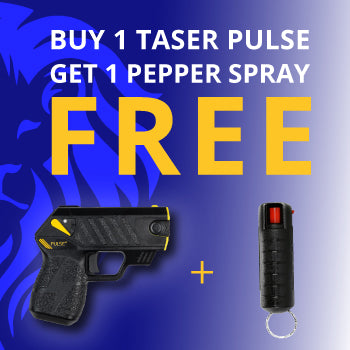Firearms and the Importance of Non-Lethal Options
The Importance of Non-Lethal Self-Defense Options When Carrying a Firearm
The decision to carry a firearm for self-defense is a weighty one, marked by the recognition of potential threats to personal safety. While a firearm can be a powerful tool, there's a growing acknowledgment of the importance of non-lethal self-defense options. In this comprehensive exploration, we'll delve into the reasons why incorporating non-lethal alternatives into your self-defense strategy is not just wise but essential for a well-rounded and responsible approach to personal safety.
Recognizing the Gravity of Using Deadly Force
While a firearm is undoubtedly a potent means of self-defense, it comes with significant legal, ethical, and moral considerations. The use of lethal force is justified only in situations where there is an imminent threat to life. Carrying and potentially using a firearm requires a deep understanding of the legal consequences and a commitment to using deadly force responsibly.
De-Escalation and Conflict Resolution
Non-lethal self-defense options contribute to a proactive approach centered on de-escalation and conflict resolution. Tools such as pepper spray, stun guns, or personal alarms provide individuals with means to defuse a situation before it escalates to a point where lethal force might be the only perceived option.
Legal Implications of Non-Lethal Options
Utilizing non-lethal self-defense tools often carries fewer legal consequences than using lethal force. Understanding the legalities surrounding these options is crucial, ensuring that you remain within the bounds of the law while still taking active steps to protect yourself.
Matching the Response to the Level of Threat
Not every threatening situation requires a lethal response. Non-lethal options provide a spectrum of responses, allowing individuals to tailor their actions to the specific threat level. This versatility is particularly valuable in scenarios where the use of a firearm might be excessive.
Personal Safety in Urban Environments
In urban environments where close-quarter encounters are more likely, non-lethal options become increasingly relevant. Using a firearm in a crowded area poses inherent risks, and non-lethal tools offer a safer means of self-defense without compromising the safety of bystanders.
Protecting Against Unintended Consequences
The discharge of a firearm, even in self-defense, can have unintended consequences. Stray bullets can pose a threat to innocent bystanders, and the psychological impact on witnesses can be significant. Non-lethal options provide a means of protecting oneself without the potential for irreversible harm.
Training and Accessibility
Effective self-defense goes beyond having the right tools; it involves proper training and familiarity with the chosen options. Non-lethal tools often have a shorter learning curve, making them accessible for a wider range of individuals. Training in their use enhances confidence and ensures responsible and effective deployment.
Building a Comprehensive Self-Defense Mindset
Incorporating non-lethal options into your self-defense strategy contributes to a holistic mindset focused on personal safety. Recognizing that not every threat requires lethal force reinforces the idea that self-defense is about protection, not aggression.
Examples of Non-Lethal Options
- Pepper Spray: A widely used option, pepper spray incapacitates attackers by causing temporary blindness and difficulty breathing.
- Stun Guns/Tasers: These devices deliver an electric shock, immobilizing the attacker temporarily.
- Personal Alarms: Emitting a loud, attention-grabbing sound, personal alarms can deter potential threats and attract help.
- Flashlights with Strobe Function: High-intensity lights with a strobe function can disorient and surprise potential assailants, providing an opportunity for escape.
The decision to carry a firearm for self-defense is a personal one that demands responsibility and a thorough understanding of its implications. In embracing non-lethal self-defense options, individuals enhance their ability to protect themselves while minimizing risks to others and themselves. In my experience as a police officer, I have had to use non-lethal force options many times in my career. While I always had my duty weapon available my time as a street cop has taught me the value of use of force options. A comprehensive approach to personal safety involves not only being prepared to use force when necessary but also prioritizing de-escalation, conflict resolution, and responsible, measured responses. Non-lethal tools, when integrated into a well-rounded self-defense strategy, contribute to a safer and more compassionate approach to personal security.


